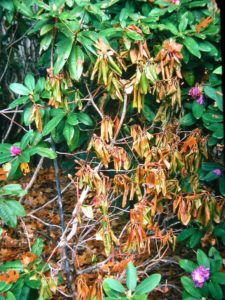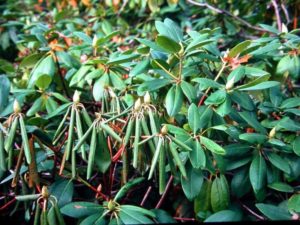
Phytophthora Root Rot is an extremely damaging and widespread fungus-like organism that will rot away your trees/shrubs root system and eventually kill your tree if left untreated. In the worst cases, when left untreated trees can become structurally unsafe and uproot or snap possibly causing property damage and injury. On older plants may show symptoms for a season or more before death; however, younger plants can die within two weeks of showing symptoms.
Susceptible Species:
Phytophthora affects a wide range of plants. In the DC metro area, our arborists typically see Phytophora on the following hosts: Azalea, rhododendron, Japanese holly, boxwood, hemlock, mountain laurel, dogwood, fir, camellia, white pine, oaks, beech, fruit trees, sugar & red maples.
Above Ground Symptoms Of Phytophthora Root Rot include
- Suppressed growth
- Poor Vigor
- Yellow or undersized needles/leaves
- Premature needle/leaf drop
- Branch dieback
- Drooping of leaves
- Curling of leaves
- Leaves turning brown
- Death – if not treated or removed
- Loss of dark green color


Need Help With Phytophthora Root Rot?
Meet With A Certified Arborist
Or Call 703-573-3029
Factors Favoring Phytophthora Root Rot
High soil moisture and warm soil temperature favor Phytophthora Root Rot. The disease is common in areas where run-off or rainwater collects around the roots of plants. Overwatering your plants can also lead to the development of Phytophthora.
Prevention & Treatments:
Purchase Disease Free Plants: Since most plants never truly get rid of Phytophthora Root Rot once infected it’s very important to make sure the plants you buy are disease free. Buy plants at a reputable nursery and avoid plants that lack normal green color or appear wilted.
Plant Root Rot Susceptible Plants in Well Drained Soil: Some plants are highly susceptible to Phytophthora Root Rot which means that if given the right conditions they will most likely contract Phytophthora and die. It very important to plant these species in well-drained soil since slow draining and wet soils are great breeding grounds for Phytophthora.

Plant Resistant Plants Especially In Wet Soil: Just as some plants are susceptible to Phytophthora Root Rot, some plants are naturally resistant. When you have soil conditions that favor Phytophthora you should always plant resistant cultivars.
Certain types of rhododendrons: Caroline, Martha Isaacson, Professor Hugo de Vries and Red Head
Certain types of Azales: Rhododendron poukhanese, Formosa, Fakir and Corrine Murrah
Camellia sasanqua is resistant as wells not to be confused with Camellia japonica which is highly susceptible to Phytophthora Root Rot.
Fungicide Treatment: The spread of Phytophthora Root Rot in an already infected tree/shrub can be reduced through the use of properly applied fungicide treatments. Fungicide treatment can also help stop the spread of Phytophthora to other plants in your landscape.
Tree Removal: In certain cases removing a tree infected with Phytophthora Root Rot is the best choice. Trees that already suffered extensive root damage are not structurally safe and can snap and uproot in a storm. Trees in this situation are extremely dangerous and need to be removed as soon as possible.
If you think your trees or shrubs are infected with Phytophthora Root Rot book a consultation with our Arborist online or by calling 703-573-3029. Our Certified Arborists will be able to develop the best treatment and help you institute preventative measure to stop the spread Phytophthora Root Rot to new trees/shrubs.


